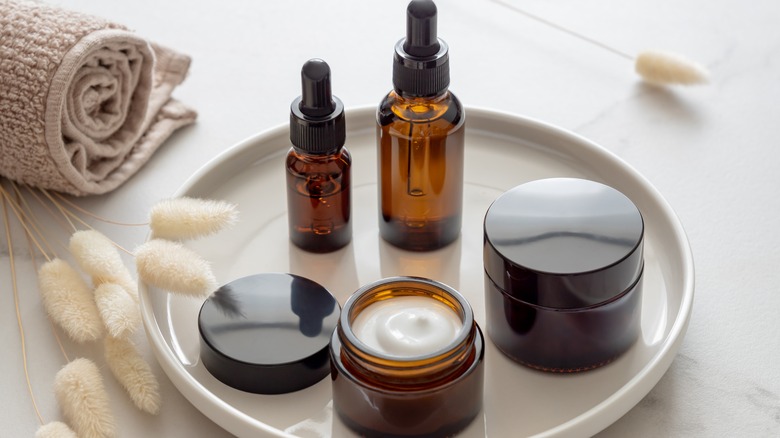Hyaluronic Acid Vs. Ceramides: Which Skin Care Ingredient Keeps You Better Moisturized?
If you've been on the market for any type of moisturizer lately, whether for face or body, you've likely run into two commonly-touted ingredients: hyaluronic acid and ceramides. This might leave you wondering what exactly these moisturizing agents are, how they work, and which might be best for your particular skin needs and concerns. The first thing you need to know, is that hyaluronic acid and ceramides are two completely different things and work in two different ways to keep skin hydrated and healthy. First, let's take a look at hyaluronic acid.
Hyaluronic acid is gel-like and works to keep skin hydrated and plump by attracting and retaining water (via Cleveland Clinic). It is a naturally-occurring substance in the human body, and you have the most of it in your joints, your eyes, and your skin. In your joints, it helps to lubricate and keep them moving fluidly and comfortably, it keeps your eyes moisturized and comfortable, and in your skin it helps to plump, reduce lines and wrinkles, and assist in healing.
Hyaluronic acid is considered quite safe to use on your skin, and it very rarely causes any type of negative reaction. It is therefore considered safe to use when pregnant and breast feeding also. It can be found in all sorts of topical products from face creams to serums to eye patches to body lotions.
About Ceramides
Ceramides, on the other hand, are fatty acids, and they too occur naturally in your skin (via WebMD). Ceramides are in charge of keeping your skin's natural barrier healthy and intact, thereby preventing infection and dryness. The outer layer of your skin, also called your epidermis, is 30% – 40% made of ceramides. Your level of ceramides can naturally decrease with age or with exposure to harsh weather, harsh soaps, or due to conditions like eczema. Replenishing lost ceramides helps to restore moisture, protect your skin barrier, and relieve irritation and dryness.
Depending on the issue you are trying to resolve, a dermatologist might suggest you use a product containing ceramides along with an anti-inflammatory ingredient or penetration-enhancing ingredient to help the ceramides absorb as well as possible. Ceramides themselves are also considered safe and well-tolerated by most people, since they are fatty acids that naturally occur on your skin already.
But which is better for you, personally?
Which is best for your skin?
The honest answer is that while both hyaluronic acid and ceramides are essential and naturally-occurring in your skin, ceramides could be considered just a little more important, as they help build your skin barrier. As such, hyaluronic acid, which lives deeper in your skin, can't be protected or properly do its job without a healthy skin barrier. Hyaluronic acid is a wonderful ingredient to help your skin feel and appear well-hydrated and plump, and it can help decrease the appearance of fine lines and wrinkles that naturally occur with age, but look more pronounced when skin is dehydrated.
Ceramides, on the other hand, can help ensure your skin remains safe and healthy by shoring up its natural barrier and preventing things like redness, irritation, excessive dryness, or susceptibility to infection or other skin conditions. At the end of the day, therefore, you really can't go wrong by getting both of these ingredients into your skincare routine, depending on your needs and any recommendations from your dermatologist or other skincare professional.


